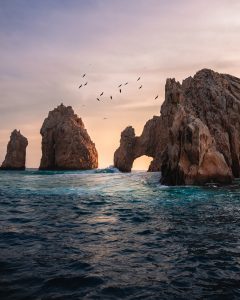Bordering the USA to the north at the spectacular Copper Canyon and connecting with the Central American countries of Guatemala and Belize to the south, Mexico’s unique geographic position lends it some remarkable diversity. The Gulf of Mexico runs along ,uch of its eastern coast, and the Caribbean Sea laps the eastern seaboard of the Yucatan Peninsula. The western coast forms the boundary of the Pacific Coast, but the long peninsula known as Baja California also creates the marine haven of the Sea of Cortez. Effectively a bridge between continents, Mexico is a country rich in its own cultural heritage, but its influence in the cultures of its neighbors is clear. Cultural attractions include Mexico City, Guadalajara, Guanajuato, Morelia, and Oaxaca.

The Cabo Arch, Bay of San Lucas, Baja California
One of the key attractions is the marine wonderland along the west coast which makes Mexico a popular destination for scuba divers. The Sea of Cortez is a migration spot for humpback whales, manta rays, whale sharks, hammerheads, as well as being home to a population of bull sharks and sea lions. It is also the location of the amazing mobula ray encounters, where thousands of these large rays gather and often jump out of the water. Orcas often follow along to prey on the rays. On the other side of Baja California is Magdelena Bay, home to the world’s second largest sardine run. This annual event attracts hundreds of sharks, whales and dolphins, as well as some rare pelagic fish such as marlins. Then, a day’s voyage offshore is the Mecca of the Socorro Islands, an area famed for megafauna encounters such as whales, many species of sharks, curious Pacific mantas, and massive schools of pelagic fish. It is truly a world class diving destination.
Mexico is one of the most popular tourist destinations in the world – its 45 million international visitors in 2019 ranked it number 7 in the world. Tourism therefore plays an important role in the Mexican economy and accounts for 8.5% of its GDP. The arrival of COVID then affected many livelihoods here. The virus was first reported in January 2020 and the government designed a Preparation and Response Plan before the global pandemic was announced. Nationwide fears caused the Mexican stock exchange to fall to record lows in March, and as a response bars, nightclubs, movie theaters, and museums were closed in Mexico City, as well as national monuments, sports events, and flights from North America were suspended. Curfews began in April and all international flights were eventually stopped. Flights would only resume again in late September.
Overall, Mexico has been one of the worst hit counties in the world according the official declared statistics. To date, 3,500,000 cases have been reported and 260,000 deaths, making it the 4th worst in the world in terms of total deaths, and 19th in terms of the worst death rate per capita. It experienced a first big wave in June to August 2020, and December 2020 – February 2021, and again during July and August 2021. Furthermore, excess death statistics indicate that deaths have been under-reported during the pandemic by 1.3 times (130%), meaning real deaths are nearer to 600,000. Up to date, 27% of the population are fully vaccinated.
Currently Mexico is open and international arrivals are not required to provide a negative COVID test result upon arrival. Further information on entry requirements can be found here: Visit Mexico![]() .
.
All 3 of our main diving destinations for Mexico liveaboards are now open:
1. The Socorro Islands (the Revillagigedos) are 250 miles (400 km) offshore from Cabo San Lucas. Known as “The Galapagos of Mexico”, it is famed for big fish action (tuna, marlin, wahoo etc), as well as Pacific manta rays, sharks (hammerheads, silkies, oceanic whitetips, silvertips, Galapagos sharks, tiger sharks and whale sharks), dolphins and even humpback whales. The season is November-May, with January-April being the coolest and best time for whales, other times better for sharks and rays.
2. The Sea of Cortez/Gulf of California is a long, thin stretch of calm water, and it is bursting with marine life. Vast schools of hammerhead sharks, colonies of sea lions, manta rays, breaching mobula rays and magnificent whale sharks. Also frequently spotted are vast pods of dolphins, porpoises, pilot whales, killer whales, sperm whales, humpbacks, and even gray whales are common here in this aquarium-like marine haven. Unlike other dive locations on the Pacific side of Mexico, there are also plenty of smaller creatures to see, as well as healthy reef scenes – sea horses, nudibranchs, morays, jawfish, and a variety of damselfish and angelfish. July-October is the Sea of Cortez liveaboard season.
3. Guadalupe is a volcanic island 165 miles (265 km) west of Baja California and is a mecca for great white shark cage diving. Guadalupe’s shark population is said to be one of the most prolific on earth and the visibility here is usually excellent. From August-October you can join liveaboard trips here to see the giant sharks that are attracted to feed on the colonies of fur seals and elephant seals.